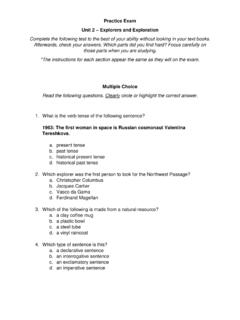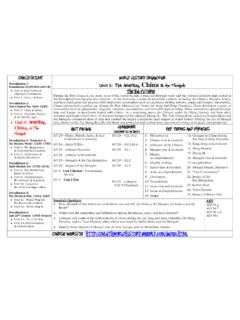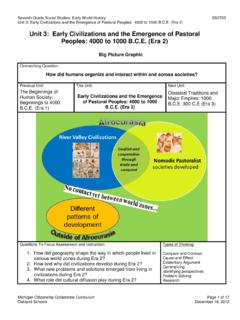Transcription of World History Semester 1 :: Units 1-4 - Mr. Lange's ...
1 World History Semester 1 :: Units 1-4. World History : The Human Experience. New York: Glencoe/McGraw-Hill, 2001. unit 1: The Rise of Civilizations Chapter 1 Human Beginnings Section 1 Discovery of Early Humans in Africa - Section 1 Assessment #1-5. Section 2 The Appearance of Homo Sapiens - Section 2 Assessment #1-5. Section 3 Emergence of Civilization - Section 3 Assessment #1-5. Chapter 2 Early Civilizations Section 1 The Nile Valley - Section 1 Assessment #1-5. Section 2 The Fertile Crescent - Section 2 Assessment #1-5. Chapter 3 Kingdoms and Empires in the Middle East Section 2 Early Israelites - Section 2 Assessment #1-5. Section 3 Empire Builders - Section 3 Assessment #1-5. unit 1 Primary Source Library - Interpreting Primary Sources #1-4. unit 1 Bridge to the Past - Gilgamesh - Responding to Literature #1-4. unit 1 History Assessment: Imagine you are an archaeologist researching ancient civilizations. Write an article to be published in National Geographic Magazine on your findings describing the major features of early human civilizations.
2 Describe how humans began settling into areas and creating civilizations. Discuss the common cultural, economic, social, and geographical features of the ancient civilizations. (Min. 3 paragraphs). unit 2: Flowering of Civilizations Chapter 4 The Rise of Ancient Greece Section 1 Beginnings - Section 1 Assessment #1-5. Section 3 Rivals - Section 3 Assessment #1-5. Chapter 5 The Height of Greek Civilization Section 1 Quest for Beauty and Meaning - Section 1 Assessment #1-5. Section 2 The Greek Mind - Section 2 Assessment #1-5. Chapter 6 Ancient Rome and Early Christianity Section 1 The Roman Republic - Section 1 Assessment #1-5. Section 3 The Roman Empire - Section 3 Assessment #1-5. Section 4 The Rise of Christianity - Section 4 Assessment #1-5. Chapter 8 India's Great Civilization Section 2 Rise of Buddhism - Section 2 Assessment #1-5. Chapter 9 China's Flourishing Civilization Section 2 Three Ways of Life - Section 2 Assessment #1-5. unit 2 Primary Source Library - Interpreting Primary Sources #1-4.
3 unit 2 Bridge to the Past - Antigone by Sophocles - Responding to Literature #1-4. unit 2 History Assessment: Identify and describe the impact that ancient Greece and Rome have had on modern society. What values, systems of government, and/or philosophies that were introduced in Greece or Rome do we still use or are still relevant today? Cite at least four examples with two from each civilization. (Min. 2 paragraphs). unit 3: Regional Civilizations Chapter 11 Islamic Civilization Section 1 A New Faith - Section 1 Assessment #1-5. Section 2 Spread of Islam - Section 2 Assessment #1-5. Chapter 12 The Rise of Medieval Europe Section 2 Medieval Life - Section 2 Assessment #1-5. Section 3 The Medieval Church - Section 3 Assessment #1-5. Section 4 Rise of European Monarchy - Section 4 Assessment #1-5. Chapter 13 Medieval Europe at Its Height Section 1 The Crusades - Section 1 Assessment #1-5. Chapter 15 The Americas Section 1 The Early Americas - Section 1 Assessment #1-5.
4 Section 2 Early Mesoamerican Cultures - Section 2 Assessment #1-5. Section 3 The Aztec and Inca Empires - Section 3 Assessment #1-5. unit 3 Primary Source Library - Interpreting Primary Sources #1-4. unit 3 Bridge to the Past - Four Poems by Li Bo - Responding to Literature #1-4. unit 3 History Assessment: Create a journal from the perspective of a peasant living in Medieval Europe. Describe what your day-to-day life is like with at least six different entries into your journal. Include specific details of the era, including World events, explanation of the monarchy, and the role of the Church in everyday life. (Min. 6 journal entries). unit 4: Emergence of the Modern World Chapter 16 Renaissance and Reformation Section 1 The Italian Renaissance - Section 1 Assessment #1-5. Section 3 The Protestant Reformation - Section 3 Assessment #1-5. Chapter 17 Expanding Horizons Section 1 Early Explorations - Section 1 Assessment #1-5. Section 2 Overseas Empires - Section 2 Assessment #1-5.
5 Chapter 18 Empires of Asia Section 1 Muslim Empires - Section 1 Assessment #1-5. Section 2 Chinese Dynasties - Section 2 Assessment #1-5. Chapter 19 Royal Power and Conflict Section 2 England - Section 2 Assessment #1-5. Section 5 Russia - Section 5 Assessment #1-5. unit 4 Primary Source Library - Interpreting Primary Sources #1-4. unit 4 Bridge to the Past - The Prince by Machiavelli - Responding to Literature #1-4. unit 4 History Assessment: How does the phrase God, gold, and glory define the age of exploration by European countries during the 1500s-1600s? Choose one nation that was active in exploration during this time and analyze how each term (God, gold, glory) drove them to discover new lands around the World . (Min. 3 paragraphs). World History Semester 2 :: Units 5-8. World History : The Human Experience. New York: Glencoe/McGraw-Hill, 2001. unit 5: Age of Revolution Chapter 20 Scientific Revolution Section 1 New Scientific Ideas - Section 1 Assessment #1-5.
6 Section 3 Triumph of Reason - Section 3 Assessment #1-5. Chapter 21 English and American Revolutions Section 3 Road to Revolt - Section 3 Assessment #1-5. Section 4 A War for Independence - Section 4 Assessment #1-5. Chapter 22 The French Revolution Section 2 Constitutional Government - Section 2 Assessment #1-5. Section 3 Dawn of a New Era - Section 3 Assessment #1-5. Section 4 Napoleon's Empire - Section 4 Assessment #1-5. unit 5 Primary Source Library - Interpreting Primary Sources #1-4. unit 5 Bridge to the Past - Les Mis rables by Hugo - Responding to Literature #1-4. unit 5 History Assessment: Vive la r volution! Create a pamphlet, poster, or letter convincing people to join the French Revolution. Include what life is currently like for you and your fellow common French countrymen and what you intend to change with the new French Republic. (Min. 2 paragraphs). unit 6: Industry and Nationalism Chapter 23 Age of Industry Section 2 The Beginnings of Change - Section 2 Assessment #1-5.
7 Section 3 The Growth of Industry - Section 3 Assessment #1-5. Chapter 24 Cultural Revolution Section 1 New Ideas - Section 1 Assessment #1-5. Section 3 Popular Culture - Section 3 Assessment #1-5. Chapter 25 Democracy and Reform Section 4 Expansion of the United States - Section 4 Assessment #1-5. Section 5 Latin American Independence - Section 5 Assessment #1-5. Chapter 27 The Age of Imperialism Section 2 The Partition of Africa - Section 2 Assessment #1-5. Section 3 The Division of Asia - Section 3 Assessment #1-5. Section 4 Imperialism in the Americas - Section 4 Assessment #1-5. unit 6 Primary Source Library - Interpreting Primary Sources #1-4. unit 6 Bridge to the Past - The Beggar by Chekhov - Responding to Literature #1-4. unit 6 History Assessment: Write a paper describing what you consider to be the most important advancement in science or technology from the Industrial Revolution era (1700s-early 1900s). Discuss its inventor/creator, the original need for the invention, and its uses.
8 Last, present an argument as to why you think it was the most important innovation of the era, and what its lasting impact is on modern society. (Min. 3 paragraphs). unit 7: World in Conflict Chapter 28 World War I. Section 2 The Spark - Section 2 Assessment #1-5. Section 3 The War - Section 3 Assessment #1-5. Section 4 The Russian Revolution - Section 4 Assessment #1-5. Chapter 29 Between Two Fires Section 3 Fascist Dictatorships - Section 3 Assessment #1-5. Section 4 The Soviet Union - Section 4 Assessment #1-5. Chapter 30 Nationalism in Asia, Africa, and Latin America Section 2 India's Struggle for Independence - Section 2 Assessment #1-5. Chapter 31 World War II. Section 1 The Path to War - Section 1 Assessment #1-5. Section 3 A Global Conflict - Section 3 Assessment #1-5. Section 5 Allied Victories - Section 5 Assessment #1-5. unit 7 Primary Source Library - Interpreting Primary Sources #1-4. unit 7 Bridge to the Past - Gifts of Passage by Rau - Responding to Literature #1-4.
9 unit 7 History Assessment: Create your own fascist/totalitarian government. You must include the following: a name and symbol for your fascist state, a piece of propaganda (examples: poster, newspaper article, etc.), a mock lesson plan for a day in school describing what your students will be taught, and a list of ten commandments for your state. unit 8: The Contemporary World Chapter 32 The Cold War Section 1 The East-West Split - Section 1 Assessment #1-5. Section 2 The Communist Bloc - Section 2 Assessment #1-5. Chapter 35 The Middle East Section 1 Nationalism in the Middle East - Section 1 Assessment #1-5. Section 2 War and Peace in the Middle East - Section 2 Assessment #1-5. Chapter 36 Latin America Section 2 Mexico and the Caribbean - Section 2 Assessment #1-5. Section 4 South America - Section 4 Assessment #1-5. Chapter 37 The World in Transition Section 1 The End of the Cold War - Section 1 Assessment #1-5. Section 5 Global Interdependence - Section 5 Assessment #1-5.
10 unit 8 Primary Source Library - Interpreting Primary Sources #1-4. unit 8 Bridge to the Past - Modern Poems - Responding to Literature #1-4. unit 8 History Assessment: Prepare a speech to be given at the General Assembly of the United Nations describing the Arab-Israeli conflict. Identify both sides that are in conflict, the History of their conflict, and what each of their goals/aims are. Your speech must also include a proposition or idea for ending the conflict. How would you bring both sides to an agreement? What is a solution that would work for all parties involved? (Min. 2 paragraphs).







